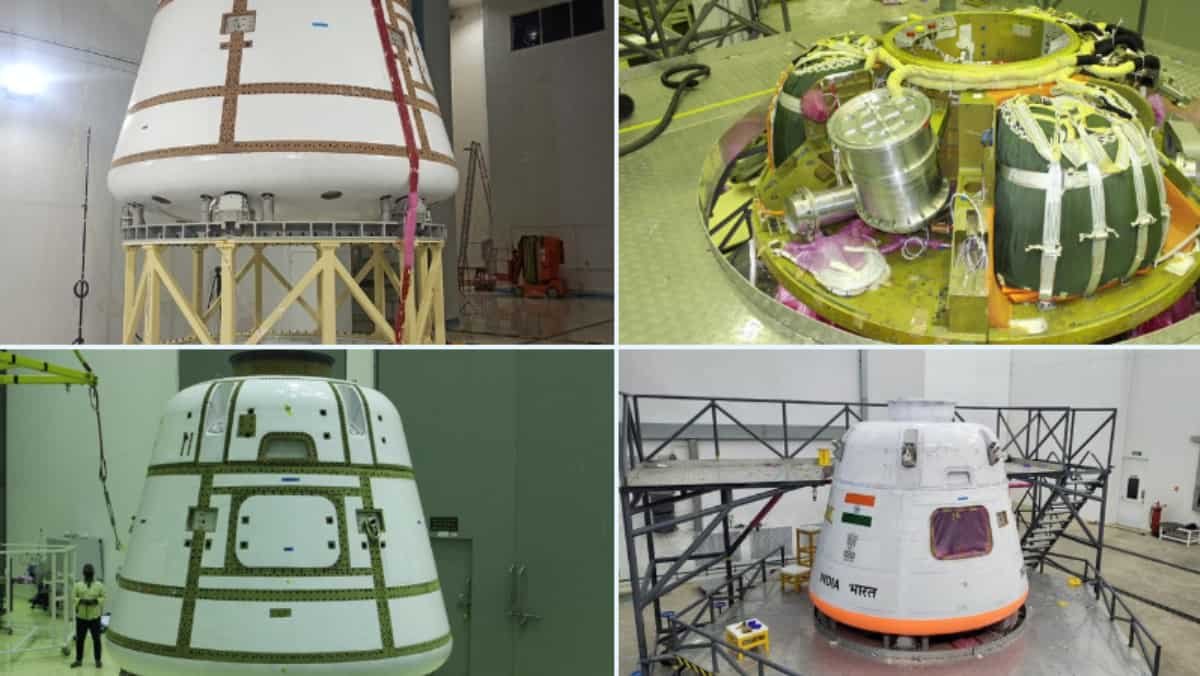While developing a fighter plane, it is crucial to prove the mechanism to eject the pilot(s) safely, mid-flight. Likewise, while working towards an astronaut mission, it is of utmost importance to prove the mechanism to eject the crew module (astronaut-carrying shell) to safety, when the rocket is mid-flight. The Indian Space agency ISRO is now gearing up for the maiden mid-flight eject test, in preparation for its human spaceflight mission Gaganyaan. By the end of this month, ISRO is expected to perform the mission known as TV-D1 or Test Vehicle Development Flight 1.
The Crew Module (CM)is where the astronauts are nestled in. It is maintained in a pressurized earth-like atmospheric condition during the Gaganyaan mission, for the safe sustenance of the astronauts. The CM for the Gaganyaan mission is in different stages of development. For the Test Vehicle Abort mission-1 (TV-D1), the CM is an unpressurised version that has completed its integration and testing and is ready to be shipped to the launch complex. This unpressurised CM has the overall size and mass of the actual Gaganyaan CM. It houses all the systems for the deceleration and recovery, which includes multiple parachutes and associated systems.
trending now
-
First Gandhi Museum in North America opens in Houston
-
Asian Games live updates: India makes history with 100 medals
-
PM Modi’s assassination threat, demands for Bishnoi’s release in email triggers heightened security: Report
-
Top 10 world news: Nobel Peace Prize winner, death toll after strike in Ukraine’s Hroza rises to 52, and more
-
After Kim-Putin meet, train traffic between North Korea and Russia spikes
-
Who was Jaswant Singh Gill, the insipiration behind Akshay Kumar’s Mission Raniganj
-
Ariana Grande and Dalton Gomez settle divorce, singer to pay $1,25 million to ex-husband
-
IND Vs AFG Live Streaming: How to watch India vs Afghanistan Asian Games 2023 Cricket Final match LIVE
-
Diplomatic tit-for-tat: US expels Russian embassy officials after similar move by Moscow
-
IND Vs AFG Asian Games 2023 Cricket Final: Check head-to-head stats and more ahead of India vs Afghanistan
-
Mean Girls reunion! Lindsay Lohan, Amanda Seyfried, Lacey Chabert seen shooting for secret project in LA
-
BAN vs AFG Head-to-head: World Cup 2023-Bangladesh vs Afghanistan pitch report, weather update, live streaming
-
Vivek Ramaswamy slams Zelensky’s bid for more US funds
-
IND vs AFG Asian Games 2023 Cricket Final: Check date, time, venue, squad, weather forecast and pitch report
-
Moscow losing influence in Central Asia? After Kyrgyzstan, Kazakhstan mulls limiting use of Russian language
The avionics systems in CM are in a dual redundant mode(even if one fails, the backup systems takeover) configuration for navigation, sequencing, telemetry, instrumentation and power. The CM in this mission is designed to capture the flight data for evaluation of the performance of various systems.
During the TV-D1 mission, the crew module and associated systems will be mounted atop a mini-rocket known as Test vehicle. This is a liquid-fuelled mini rocket based on the L40 stage booster of the GSLV(erstwhile GSLV Mk2) rocket. Mid-flight, as the required conditions(Mach 1.2 or 1.2 times the speed of sound) are achieved, the Crew escape system and crew module would eject from the rocket, when the vehicle is at an altitude of 17 kms. thereafter, the crew module will be carried to a higher altitude(away from the rocket) and then it would use onboard parachutes to decelerate and gradually splash down in the sea, about 10kms from the coast of the spaceport in Sriharikota. After splashdown, the Crew Module will be recovered, using a dedicated vessel and diving team from the Indian Navy.
ISRO said that the Crew Module underwent electrical testing, at ISRO’s facility in Bengaluru, including an acoustic test and was dispatched to the spaceport on 13th August. At the spaceport, it will undergo vibration tests and pre-integration with the Crew Escape System, before final integration to the Test Vehicle at the Launch Pad.
This Test Vehicle mission with this CM is a significant milestone for the overall Gaganyaan program as a near-complete system is getting ready for a flight test. The success of this test flight will set the stage for the remaining qualification tests and multiple unmanned missions, leading to the first Gaganyaan mission with Indian Astronauts, ISRO said.
Meanwhile, ISRO has also taken possession of a crew module shell. This shell is meant to be used for air-drop tests of the same. Air drop tests are another means of testing the parachute systems of the crew module, by dropping it from a flying helicopter. WION had reported on the delivery of the new crew module shell.


)
)
)
)
)
)
)
)
)
)
)
)
)
)
)